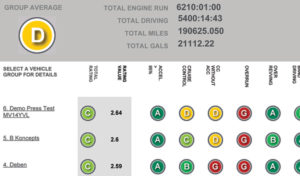
Modern trucks generate vast amounts of data via telematics and other digital tools such as advanced driver assistance systems (for example, autonomous emergency braking). There are many for it and new applications are popping up all the time, one of which is reactive safety systems for hauliers and drivers.
Fleet management and technology specialist Microlise is developing a function for truck fleets that blends vehicle tracking data – i.e. how and where lorries have driven – with local information from other sources such as traffic, accident and weather reports, to paint as comprehensive a picture as possible of the road and the conditions.
Matt Hague, Executive Director for product strategy at Microlise, explains: “There’s a lot of data captured around cars, but this is all about heavy goods vehicles: what flow rates look like around cities, counties on motorways, trunk roads or in urban environments at different times of the day, but also, crucially, where the risk areas are. Where are the incidents that you might be seeing around harsh braking, harsh cornering or anti-roll activation?”
“You can start to paint a picture and overlay it with statistical data in terms of accident black spots, but also external data sources like weather, traffic, accident data, local authority data, bridge data – and bring all of that together to develop a set of algorithms that looks at that big data ‘lake’ and basically creates hot spots of risk.”
The system has a working title of ‘Driver Hazard Warning’, and the company is set to begin field trials with two of its existing customers in December, while a fully-fledged launch is expected in the first quarter of 2018. The service will also be able to tap into existing fleet management systems, to advise on routes with safety and efficiency in mind.
“We’ve done some development at a transport operator level, that will allow them to make decisions about what routes they decide to take a vehicle on from a planning perspective,” says Hague, “[hauliers are] potentially using an optimisation engine to give them the most cost-effective routes, hit their delivery windows, cover the least mileage, have the best fuel economy etc.”
“When those routes come into our system, the algorithm basically overlays the risks – the accident spots, the low bridges, traffic, weather data – and it gives that route a risk score. That doesn’t mean you’re going to change that route, but it does mean you might brief [the driver] or you might put a different driver on it. You might use a permanent driver that you know, rather than a sub-contractor, for example.”
The final component is an audible warning, inside the cab, which happens when the vehicle is approaching a tricky bit of road. Drivers will be able to download their end of the system in an app format for a smartphone or a tablet, but it will also be possible to install it in other formats, such as fixed screens in the cab.
“As they’re driving along, it actually proactively warns the driver, and highlights that, based upon how everyone else has driven, plus all of these external data sources and the fact that it’s raining or it’s at this time of the day, you should be cautious at [a particular] intersection,” says Hague, who describes the prompts as similar in nature to speed camera warnings on consumer satellite navigation units.
“It’s going to give them that heads-up to say ‘you are coming up to a roundabout that is an accident black spot or a harsh braking spot,’ so it’s almost like having a passenger who’s driven that route daily in the cab. If you’ve never been there before and that passenger’s going, ‘just be careful when you come down to this junction,’ or ‘don’t go down there mate, because according to 28,000 Network Rail bridge data points, given your height, you won’t get under it’.
Though it will initially be aimed at haulage fleets, Hague believes that the Driver Hazard Warning system could, in time, become an out-of-the-box feature that’s offered by manufacturers. “Right now, it’s something that we’re being asked for by our fleet operator customers, but – the ability to be able to up-sell apps via the OEM or via a service they provide – I can see that changing over time, and a number of OEMs are already talking to us on that basis.”
Microlise is far from the only telematics company working on such technology, and shared formats of big data are set to become more common as connected vehicles and technology increase and develop. Furthermore, Hague believes that cross-referencing big data from multiple sources is a fundamental step towards autonomous trucks.
“Where I can see that leading to ultimately is, in 10 years time, allowing vehicles to take that step towards autonomy, because they’ve got the ability to have context, based on that collective learning.
“When that vehicle is driving down the road and using its vision systems, its radar systems, to work out where it is, the one thing it won’t be that good at, particularly if it’s never been there before, is what the human computer is extremely good at: we read and look at all of the information in front of us, and we have past experience to learn and to be able to contextualise.
“I see that big data and shared learning piece being really, really powerful for added context [for the vehicle]. Right now, we’re feeding it through to a driver, but I can see that kind of information being fed into a truck’s ECU, for example, so it can make decisions based upon all the other inputs that it’s getting, to give it context and allow it to make decisions. That might all sound a bit sci-fi but I absolutely see it happening.”











